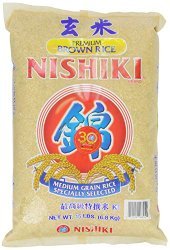There are certain foods that come to mind when people think about getting big. Chicken breast, beef, egg whites and other sources of protein are probably some of the first few foods that people associate with building muscle but good carbohydrates sources are also necessary.
Rice is a great source of carbohydrates and has been consumed for thousands of years. It is a staple food for many cultures and today it provides about a 5th of the world’s calories consumed by human.
I grew up in Hawaii which has a lot of Asian influences and for me rice was our family’s main starch when I was growing up. If you are looking for a good high-calorie carbohydrate source for look no further than this popular side-dish.
Brown Rice vs White Rice
White rice and brown rice both come in different varieties. The different types of rice are usually divided by the grain length into short, medium, and long grain categories.
The difference between the two comes from the processing. Both white and brown rice remove the outer husk from the grain seed. White rice further processes the food by removing the bran and the germ leaving only the starchy endosperm.
Brown rice has often been thought of as being more “healthy” than white rice, but is there really that much of a difference?
Removing the bran and the germ will make the rice last longer, but it also decreases the fiber and nutrients.
Some of the key nutrients that are removed along with the bran and the germ is vitamin B1, B3 and iron. The U.S. Food and Drug Administration require that these nutrients be added back into rice, which is why rice produced in the U.S. is “enriched.”
Some of the nutrients that brown rice is high in that are not added back into white rice include; Manganese, Phosphorus, Magnesium, and Zinc. So brown rice does have a lot more nutrients than white rice, so in that sense, brown rice wins hands down.
For some people these nutrients are not that big of a deal. The macros are the main thing that a lot of bodybuilders care about since a lot of nutrient needs will be handled by supplementation.
Macronutrient Breakdown of Rice
The table below shows the comparison between brown rice and white rice in the calories, macronutrients, and fiber. As you can see there are some slight differences between the 2 but they are still very similar.
| Food | Serving Size | Calories | Carbohydrates | Fiber | Protein | Fat |
| White Rice | 1 Cup | 242 | 53.2 grams | 0.6 grams | 4.4 grams | 0.4 grams |
| Brown Rice | 1 Cup | 218 | 45.8 grams | 3.5 grams | 4.5 grams | 1.6 grams |
So which one should you choose for building muscle? If you are trying to gain weight, you need calories and carbs and both have a bunch of those. I would say for a beginner, you can use either one. Just pay attention to your goal calories and macros and try to hit them.
For someone who is a little more advanced I would say it would depend on how easy it is for you to gain weight.
If you have a tough time gaining weight, the extra calories and carbs in white rice may be more of a benefit to you.
If you tend to put on a lot of fat when you bulk up, switching to brown rice may be a good choice since it has less carbs and fewer calories.
If you are a genetic freak and can easily put on muscle and not gain any fat then either rice would be OK.
Some people just want to “be healthy” so because of the extra nutrients in brown rice, I would choose it over white rice if that is your goal.
Protein Content
Ok… So rice is not a complete protein source but is does have some protein which is always a benefit from a carb food. When you are trying to hit your macros for the day every little bit counts. If you are getting 1 cup of rice at 4 different meals throughout the day that is about 18 grams of extra protein you’ll be consuming. (That’s more than some protein bars.)
As I mentioned in my previous article on protein powders, rice protein does have a lot of the amino acids cysteine and methionine but low in the amino acid lysine. The right amounts of aminos in the correct proportions are needed for protein synthesis (muscle building.)
Legumes are high in lysine and low in cysteine and methionine so it complements rice’s amino profile perfectly. It is for this reason that brown rice with some beans would be a better carb choice than brown rice alone.
Rice and The Glycemic Index
Another area of difference between brown rice and white rice will be their effect on the glycemic index. Basically this measures how much a certain food will raise insulin levels in the body.
As I said before in my article on low-glycemic foods, the glycemic index is not a steady number. It can change rather greatly depending on a bunch of factors. They can change from person to person and an change within the same person in the same day.
The Glycemic Load takes into account uses the glycemic index but also factors in the total carbohydrates.
Some studies vary greatly in their glycemic indexes, but the Harvard Medical School averaged most of the studies. Below are the numbers for rice.
| Type of Rice | Glycemic Index | Serving Size | Glycemic Load |
| White Rice | 89 | 150 grams | 43 |
| Brown Rice | 50 | 150 grams | 16 |
This glycemic index is really where the difference between brown rice and white rice stands out (although there are many individual studies that measure their glycemic index numbers pretty similarly.)
Assuming these numbers are accurate (because they can change and WILL change when you eat other foods in combination the analyzed food) white rice is a high glycemic, quick burning simple carb and brown rice is a much slower burning, low-glycemic complex carb.
Why does the glycemic index matter?

![]()
There are a few exceptions to this, but in general it is best to stick to lower glycemic foods to avoid insulin spikes which may lead to fat gain. Insulin is not necessarily a bad thing though since it is a hormone that also helps with muscle gain.
The exception to avoiding high glycemic foods that I mentioned previously was for people who have a lot of trouble gaining weight.
Another exception is after a hard intense workout. After an intense workout, your body can become depleted of glycogen and raising insulin levels can help your body bring these back to normal much quicker.
Since most bodybuilding or powerlifting workouts won’t deplete the glycogen that much, the main benefit of the raised insulin levels for building muscle is to increase the flow of nutrients like amino acids into the muscles.
There is some debate over the timing and effectiveness about raising insulin levels post-workout but I personally look to add some simple carbs to my post-workout shake when I am bulking. I will also eat a meal with carbs about an hour later and rice is an easy option to pair with a protein like chicken or beef.
Rice and Weight Loss
While rice can be a good food to help with gaining weight, if you are looking to lose weight, you may want to avoid rice (white and brown) altogether. Following a ketogenic diet seems to be the quickest way to lose weight for most people, and that requires eliminating most carbs. This would include brown rice.
Typically the magic number for a ketogenic diet is 50. Keeping your net carbs under 50 grams seems to be the standard for most low-carb diet plans. One cup of brown rice has around 46 grams of carbohydrates (with 4 grams of fiber) which is close to the daily threshold for carb consumption for that type of dietary plan.
In addition to the carbohydrates, rice does have a lot of calories in proportion to the volume of food. It can be very easy to get 500+ calories with a few scoops of rice. This is definitely not what you want if you are trying to lose.
Personally I avoid rice when I am cutting since I cut the carbs and the calories from carbs. There are some people that chose to do more of a balanced diet to lose weight and in that instance a little brown rice may be OK, but as always, look at your caloric and macronutrient goals first and make sure what you are eating fits your requirements.
Summing It Up
Building muscle isn’t just about protein you will need to get some carbs as well and brown rice is a good choice. There are a bunch of carbs in each serving of rice along with a little bit of protein.
The differences in macros are slight between brown rice and white rice and they will both give you plenty of good carbohydrates. Brown rice has the added benefit of more nutrients.
If you have any questions or comments about this article please feel free to leave a comment below or on the facebook group. Thanks for reading.






